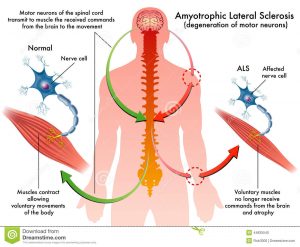Remember a few years back when the ice bucket challenge was a big thing? Everyone was doing it and the challenge went viral. Next thing I know my antisocial media mother is doing it too. She decided to create a Facebook just so she can get a bucket of ice cold water dumped on her. She didn’t do it just because all her friends were doing it or to be cool (maybe?). She did it to spread awareness about a rear and fetal disease called ALS. At first I didn’t know what ALS was or why it was taking over the world. But as time passed, I became aware of the disease and how prevalent it was.
So what is ALS?
Amyotrophic lateral sclerosis or ALS is a fetal motor neuron disease that brings upon degradation of upper and lower motor neurons. The disease attacks the motor neurons which reach from the brain to the spinal cord and from the spinal cord to the muscles throughout the body. The progressive degeneration of the motor neurons in ALS eventually leads to their demise.

Types of ALS
There are two types of ALS.
Sporadic, which is the most common, affects about 90 to 95 percent of all cases and anyone might get at any time.
Familial, which accounts for 5 to 10 percent of all cases. Familial is inheritable which means a certain mutated gene may be passed on within family members, in those families, there is a 50% chance each offspring will inherit the gene mutation and may develop the disease.
Signs and symptoms of ALS
In the beginning symptoms and signs might be overlooked, they include.
- muscle weakness or muscle atrophy (weakness in the arms and legs first)
- trouble swallowing or breathing
- cramping
As the disease progress the signs and symptoms become severe and widely noticeable. These may vary from person to person.
- Lose in mobility, speech and swallowing
- Cognitive declaim
Sensory nerves and the autonomic nervous system are generally unaffected, meaning the majority of people with ALS maintain hearing, sight, touch, smell, and taste.
What causes ALS?
Scientists have yet to pinpoint what exactly causes the disease but recent research has provided some understanding of what might be going on. A recent study has shown that oxidative stress, mitochondrial damage and protein aggregation might be the problem.
- Oxidative stress and mitochondrial damage cause RNA dysmetabolism
- RNA dysmetabolism causes oxidative stress and mitochondrial damage
- Accumulation of misfolded proteins, which can lead to the imbalance of the protein degradation pathway.
- Iron homeostasis, high levels of iron lead to oxidative stress increase.
Is there a cure?
There is no known cure for ALS but certain studies have shown that the drug Riluzole a glutamate blocker slows the progression of ALS in some people. Also therapy in improving breathing and swallowing has been shown to improve daily living conditions of people with ALS. In addition, people with ALS may experience a better quality of life in living with the disease by participating in support groups and attending an ALS Association Certified Treatment Center of Excellence or a Recognized Treatment Center.
https://www.youtube.com/watch?v=JNZcC_3YLuo
for more information please visit the ALS Association website at http://www.alsa.org/about-als/what-is-als.html?referrer=https://www.google.com/

